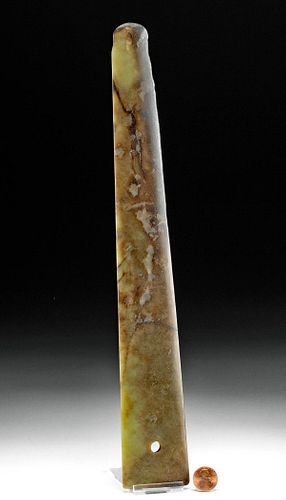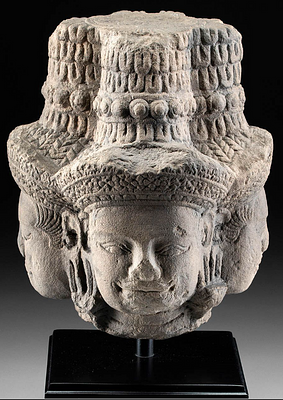Chinese Shang Dynasty Nephrite Jade Celt
Lot 69
About Seller
Artemis Gallery
686 S Taylor Ave, Ste 106
Louisville, CO 80027
United States
Selling antiquities, ancient and ethnographic art online since 1993, Artemis Gallery specializes in Classical Antiquities (Egyptian, Greek, Roman, Near Eastern), Asian, Pre-Columbian, African / Tribal / Oceanographic art. Our extensive inventory includes pottery, stone, metal, wood, glass and textil...Read more
Categories
Estimate:
$1,800 - $2,700
Absentee vs Live bid
Two ways to bid:
- Leave a max absentee bid and the platform will bid on your behalf up to your maximum bid during the live auction.
- Bid live during the auction and your bids will be submitted real-time to the auctioneer.
Bid Increments
| Price | Bid Increment |
|---|---|
| $0 | $25 |
| $300 | $50 |
| $1,000 | $100 |
| $2,000 | $250 |
| $5,000 | $500 |
| $10,000 | $1,000 |
| $20,000 | $2,500 |
| $50,000 | $5,000 |
| $100,000 | $10,000 |
| $200,000 | $20,000 |
About Auction
By Artemis Gallery
Jun 29, 2023
Set Reminder
2023-06-29 10:00:00
2023-06-29 10:00:00
America/New_York
Bidsquare
Bidsquare : Exceptional Antiquities, Ethnographic and Fine Art
https://www.bidsquare.com/auctions/artemis-gallery/exceptional-antiquities-ethnographic-and-fine-art-13031
Artemis Gallery info@artemisgallery.com
Artemis Gallery info@artemisgallery.com
- Lot Description
East Asia, China, Shang Dynasty, ca. 16th to 11th century BCE. A gorgeous nephrite jade celt boasting a smoothly-carved, elongated form and natural hues of sage, olivine, mint green, and mocha. The ceremonial instrument features one straight end drilled with a suspension hole and a gently tapering body that ends in a rounded tip. Chinese art has incorporated jade since the Neolithic period; quarries for nephrite, the formal name for jade, have been found in modern-day southern Mongolia that date to ca. 4000 BCE. The stone was prized for its hardness, its beautiful coloration), and its durability. By the third millennium BCE, we know that jade had also come to be associated with immortality. Jade was used to make everything from everyday household objects and decoration to the ceremonial suits in which Han dynasty emperors were buried – with the belief that jade would preserve the body and the soul for eternity. Size: 13.5" L x 2" W (34.3 cm x 5.1 cm)
Yu, the Chinese word for jade/nephrite, is also an idea - of a steadfastness and reliability, mirrored in the abrasion techniques required to make these intricate works of art. Yu is also not bound by the mineralogical definition of jade - over the millennia that it has been carved in China, the people have had varying access to sources of jade and nephrite - but is rather a wider term for hard stone. From the Neolithic period forward, the Chinese buried jade with the dead, often broken or placed ceremonially on the body; they also used it in life for performing rituals.
Provenance: private New Jersey, USA collection; ex-Arts du Monde, New York, USA, before 2000
All items legal to buy/sell under U.S. Statute covering cultural patrimony Code 2600, CHAPTER 14, and are guaranteed to be as described or your money back.
A Certificate of Authenticity will accompany all winning bids.
We ship worldwide and handle all shipping in-house for your convenience.
#177760Some chipping to face and blade edge near tip, as well as small nicks to surface. Natural fissures to stone in areas. Otherwise, intact and excellent with good preservation of form and mostly smooth surfaces.Condition
- Shipping Info
-
All shipping is handled in-house for your convenience. Your invoice from Artemis Gallery will include shipping calculation instructions. If in doubt, please inquire BEFORE bidding for estimated shipping costs for individual items.
-
- Buyer's Premium



 EUR
EUR CAD
CAD AUD
AUD GBP
GBP MXN
MXN HKD
HKD CNY
CNY MYR
MYR SEK
SEK SGD
SGD CHF
CHF THB
THB













